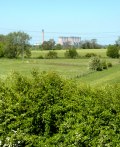 There’s a cute video montage currently doing the rounds in which a re-working of the Billy Joel song “We didn’t start the fire” reminisces about growing up in the 1970s and the 1980s and cites the countless games, toys, TV shows and other cultural references we had during that time years before anyone had an iPad, mobile phone or other essential gadget. Featured is the Rayleigh Chopper bicycle, Atari video games, Tiswas, and Swap Shop (it’s very British, did I already say?). Most of the references are positive but a few things are missing the ever-present mutually assured destruction and the threat of nuclear war and in those pre-climate change times when were knew about greenhouse gases but were worried about the coming Ice Age, there was acid rain.
There’s a cute video montage currently doing the rounds in which a re-working of the Billy Joel song “We didn’t start the fire” reminisces about growing up in the 1970s and the 1980s and cites the countless games, toys, TV shows and other cultural references we had during that time years before anyone had an iPad, mobile phone or other essential gadget. Featured is the Rayleigh Chopper bicycle, Atari video games, Tiswas, and Swap Shop (it’s very British, did I already say?). Most of the references are positive but a few things are missing the ever-present mutually assured destruction and the threat of nuclear war and in those pre-climate change times when were knew about greenhouse gases but were worried about the coming Ice Age, there was acid rain.
Researchers in India point out that acid rain was certainly a major environmental concern for North America and Western Europe during 1970s, but mitigation efforts such as the addition of sulfur scrubbers to coal-fired power stations and catalytic converters to remove acidic nitrogen oxides from vehicle exhausts, reduced significantly the amount of sulfur compounds entering the atmosphere to create the corrosive rain. Today, the chattering classes are more likely to be concerned about the sulfites in their cheap wine than sulfuric and nitric acid destroying the trees in their gardens. But, while the “West” has all but forgotten acid rain and the majority presumably assume it is no longer an issue, in the developing world acid rain is, unfortunately, alive and well and wreaking havoc year on year.
S.A. Abbasi of the Centre for Pollution Control and Environmental Engineering at Pondicherry University, India and colleagues have reviewed current understanding of the evolution of acid rain, its eradication in some parts of the world and how its emergence in the developing world, particularly the so-called BRIC nations (Brazil, Russia, India and China) will inevitably have a detrimental effect on the whole world.
Their review leads to three important conclusions concerning acid rain:
- Acid rain is a slow-acting scourge – its impacts are not dramatically evident over a short timespan unless, in exceptional cases, the acidification of the rain has taken place suddenly and sharply.
- Some regions feel the impact of acid rain more readily than others and this essentially depends on the availability, or the lack of, acid-neutralising dust/soil/water in the region.
- It is simplistic to believe that if in a particular region acidification of rain is not presently causing proportional acidification of receiving water and soil, this shall continue to be so indefinitely. If not checked, acid rain would gradually wear down the acid-assimilative capacity of the receiving environments.
“Acid rain and its effects will not go away overnight. Increasing public awareness of the problem is the first step towards finding some of the solutions. The cost of control versus the cost of damage must be considered while evaluating the merit of any management alternative. Given the fact that past studies has indicated that the benefits of acid rain control easily outweigh the costs, it is a problem not without hope,” the team concludes.
![]() Abbasi T. (2013). Acid rain: past, present, and future, International Journal of Environmental Engineering, 5 (3) 229-272. DOI:
Abbasi T. (2013). Acid rain: past, present, and future, International Journal of Environmental Engineering, 5 (3) 229-272. DOI:
Oh and that nostalgic video?